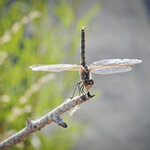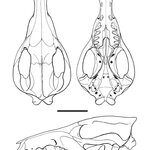Paleontology
...this turns up.
This thing is Siphusauctum gregarium, and is known from over 1000 specimens. It probably looked something like this,
The good news is that it's published in PLoS ONE so you can go check it out for yourselves.
Think it's like something you've seen before? I can see why. But actually, when you get down to the nitty gritty, this thing is very different to anything else, even from the Burgess Shale.
The most that the authors can say is that it is almost certainly an animal, and that it seems to be more complex than sponges and cnidarians (jellyfish and corals). Other than…

This is pretty funny; this is based on (supposedly genuine) letter sent to a well respected US museum. Obviously the names of institutions and individuals have been changed.
Dear Mr. Smith:
Thank you for your latest submission, labeled "93211-D, layer seven, next to the clothesline post...Hominid skull." We have given this specimen a careful and detailed examination, and regret to inform you that we disagree with your theory that it represents conclusive proof of the presence of Early Man in Charleston County two million years ago. Rather, it appears that what you have found is the head of a…

.
Many First Nations sites were inhabited continually for centuries. The discarded shells and scraps of bone from their food formed enormous mounds called middens. Left over time, these unwanted dinner scraps can transform through a quiet process of preservationTime and pressure leach the calcium carbonate, CaCO3, from the surrounding marine shells and help “embalm” bone and antler artifacts that would otherwise decay. Calcium carbonate is a chemical compound that shares the typical properties of other carbonates.
CaCO3 is common in rocks and shells and is a useful antacid for…

Dragonflies, from the order Odonata, have been around for over 250 million years. I've seen fossil dragonflies from the Eocene some 50 million years ago that would have been exquisite monsters to behold. Huge beasts taking to the skies and enjoying the warmth that the Earth was experiencing at the time.The most conspicuous difference in their evolution over time is the steady shrinking of their wingspan from well over two and a half feet down to a few inches.

The late Devonian, about 390 million years ago to roughly 360 million years ago, was a time of struggle and escape for fish in a drying environment, theorized paleontologist Alfred Romer. That circumstances and necessity for continued survival were vital in fish-tetrapod transition.
The imagery of such a drastic adaptation to changing environmental conditions may be evolving into a new picture, according to Gregory J. Retallack, professor of geological sciences at the University of Oregon. He says that his discoveries at numerous sites in Maryland, New York and Pennsylvania suggests…

A new species of horned dinosaur, Spinops sternbergorum, was announced today by an international team of scientists nearly 100 years after the initial discovery of the fossil.
Spinops sternbergorum lived approximately 76 million years ago in southern Alberta, Canada, so technically the discovery was 76 million years in the making rather than 100, but the Anthropic Principle favored by string proponents in physics says nothing counts unless we perceive it so that counts for paleontology also, it would seem. Spinops was a plant-eater that weighed around two tons when alive and was a smaller…

A newly discovered fossil, found in South America, bears resemblance to Scrat, the sabre-toothed squirrel well-known for his antics in the Ice Age movies. In reality, though, the creature is known by the slightly more complicated name of Cronopio dentiacutus. It was found in the La Buitrera locality in the Rio Negro Province, Argentina. It belongs to the dryolestoids, an extinct mammal group that belongs to the lineage that led to modern marsupials and placental mammals.
Some striking features are the short, rounded skull, the elongated rostrum (the ‘snout’) and the long canines (see figure 1…

252 million years ago there was a watershed moment in the history of life on Earth - namely that there was almost no life left on Earth. As much as 90 percent of ocean organisms were extinguished, ushering in a new order of marine species, some of which we still see today and land dwellers also sustained major losses.A new paper in Proceedings of the Royal Society B undertook an exhaustive specimen-by-specimen analysis of surviving land-based vertebrates. The survivors, a handful of genera labeled "disaster taxa," were free to roam more or less unimpeded, with few competitors in their…
A couple of months ago, I picked up on the news that Archaeopteryx had been rebumped in its* phylogeny to now sit among the dromeosaurs.
I also mentioned near the end...
I will say this, though: don't expect this to be the last you've heard of this. I think it is probably quite likely that there may be another reclassification, and Archeopteryx may find itself being reclassified as a bird again.
Now, I will politely clear my throat and point you to this article, published in Biology Letters. It took three months for someone to rebutt Xu's new phylogeny, but here we are! They have elevated…
I'll bet you've never seen a fossilized parrot before.
This is an ex-parrot. It has ceased to be. (Just couldn't resist it, apologies!)
This is the newly named Cyrilavis colburnorum from the Paleogene Green River formation, which is getting to be rather famous for the extremely well preserved birds; it's here that many of the bird specimens for plumage colour reconstruction of fossil feathers have been recovered from.
Briefly, though, I think I'll ram home once again that there is no such thing as a missing link. This fossil is a member of the stem group of parrots; a cloud of organisms…